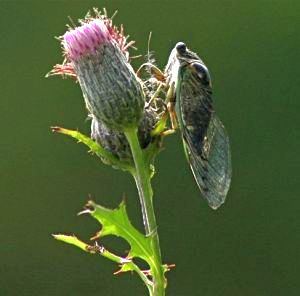 I know summer is half over because I can hear it – a buzzing in the trees that rises and falls in waves. The cicadas are singing.
I know summer is half over because I can hear it – a buzzing in the trees that rises and falls in waves. The cicadas are singing.
Every year by July 15th the annual cicadas come out in Pittsburgh, a convenient marker of summer’s midpoint. Some people call them dog-day cicadas because they appear in July.
Cicadas are harmless insects who live most of their lives underground, emerging as winged adults for a brief time to mate and die. As soon as they emerge they climb a tree and molt their exoskeleton. When I was a kid my brother and I used to collect the shells: me to examine them, he to place them in unlikely places – like on my back – as a surprise.
Most cicadas live 2-5 years underground but part of the population matures every year so they look “annual” to us. This is in stark contrast to the periodic cicadas whose entire brood emerges every 17 years, swamping the area with millions of bugs. The last time I saw this phenomenon was in Beaver County in 2002. I’m happy to see a few cicadas but that many bugs was like an insect horror flick.
The cicada’s buzz is the male’s way of attracting a mate. He’s specially equipped with timbals on the sides of his abdomen that make clicking sounds when they expand and contract and his abdomen is partly hollow to amplify the sound. He vibrates the timbals incredibly fast – and it’s loud. The noise gives away his location. That’s good for finding a mate but bad for avoiding predators.
And that’s the bird connection here. Many birds eat cicadas. The 17th year brood is probably a feast for birds but at other times they have to work hard to catch them. I’ve seen house sparrows chase them down and beat them up until they stop moving. The bugs are as big as a house sparrow’s head – a rather evenly matched battle.
For some reason I’ve never paid attention to the point when cicadas disappear. I wonder if they’re gone when the Dog Days end in September.
(photo by Chuck Tague of an annual cicada on a Swamp Thistle)
I too have a brother who would torment me with the cicadas. How I always dreaded their sound because that meant summer would soon be over.
I had the day off yesterday and saw an unusal bird at my feeder outside my window. It looked like a cardinal but had a completely black head and the body looked redder than the male cardinal. It was also quite a bit larger. I tried an internet search and one post said it is a cardinal that had a parasite that caused the feathers to change. Do you know of this? I would very much like to know. I am not handy with a camera when it comes to photographing birds but if I see it again I will try to get a picture.
Cardinals sometimes molt all the feathers off their heads and grow them all back again.
There’s a discussion about bald cardinals plus pictures at the Hilton Pond website here: http://www.hiltonpond.org/ThisWeek030701.html
Does the picture on Postscript #3 look like your bird?
No, it really does not look like what I saw. I keep hoping the bird will come back so I can get a closer look or try to photograph it. It looked like the head was covered in black feathers. Thank you for the response and the interesting link.
I spent a weekend in the summer of 2002 camping with friends in Raccoon Creek State Park; the constant cicada noise all day made it sound as though there were UFOs taking off all around us! I’m glad the periodic broods take long breaks between emergences – even if it means the birds don’t have as many of them to feed on.